Former Japanese Prime Minister Shinzo Abe was shot while giving a campaign speech in the western city of Nara, a government spokesman said Friday, as local media reported he appeared to have been shot from behind.
Abe, 67, was in cardio and pulmonary arrest after being shot, according to the local fire department, meaning he was not breathing and his heart stopped while he was being airlifted to the hospital.
He was reportedly shot a few minutes after he started talking outside of a main train station in western Nara.
NHK public television showed scenes from the chaotic scene that unfolded on Friday as the former prime minister collapsed on the street, with several security guards running toward him.
Witnesses reported hearing gunshots during the attack while Abe was making an election campaign speech ahead of Sunday’s election for the parliament’s upper house. He then collapsed holding his chest, his shirt smeared with blood.
Chief Cabinet Secretary Hirokazu Matsuno said police tackled and arrested a male suspect at the scene of the shooting.
Tetsuya Yamagami, 41, of Nara City, was arrested on suspicion of attempted murder, police said, according to NHK. A gun confiscated from the scene appeared to be homemade, police said.
It was a stunning development in a country with famously low levels of violent crime and tough gun laws, involving perhaps Japan’s best-known politician.
Former Japanese prime minister Shinzo Abe lies on the ground after apparent shooting during an election campaign for the July 10, 2022
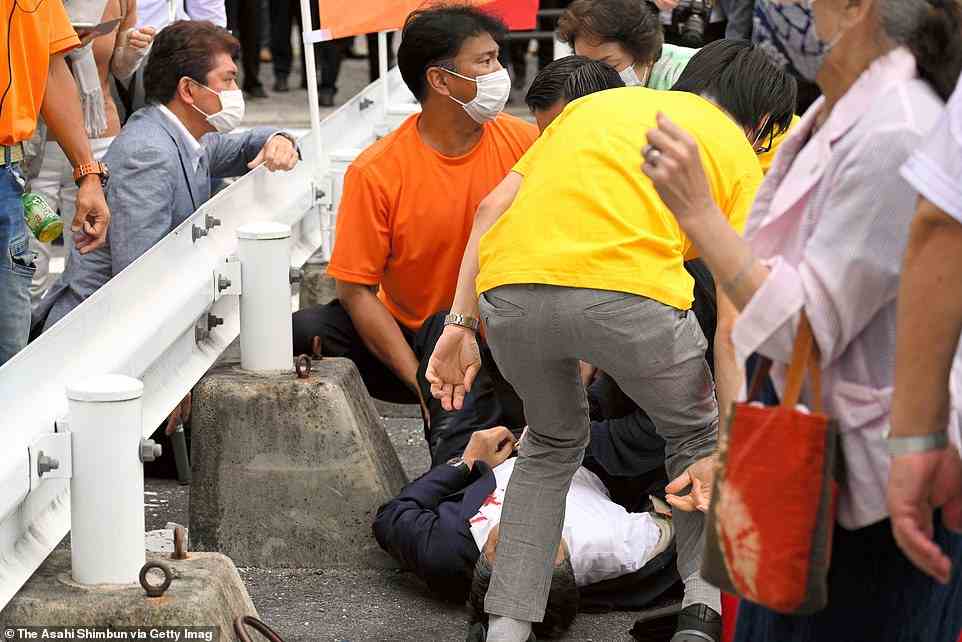
Former Prime Minister Shinzo Abe bleeds from chest on the ground after being shot in front of Yamatosaidaiji Station
‘Former prime minister Abe was shot at around 11:30 am,’ in the country’s western region of Nara, chief cabinet secretary Hirokazu Matsuno told reporters.
‘One man, believed to be the shooter, has been taken into custody. The condition of former prime minister Abe is currently unknown.’
‘Whatever the reason, such a barbaric act can never be tolerated, and we strongly condemn it,’ Matsuno added.
The suspected gunman, who was tackled at the scene and arrested, is a former soldier who was in the Japanese self-defense forces and appears to have built the improvised weapon used in the shooting, Radio 4 reported.
It was reported that Abe had his security team around him, but the attacker was able to pull this gun out and shoot him at close range ‘without being checked.’
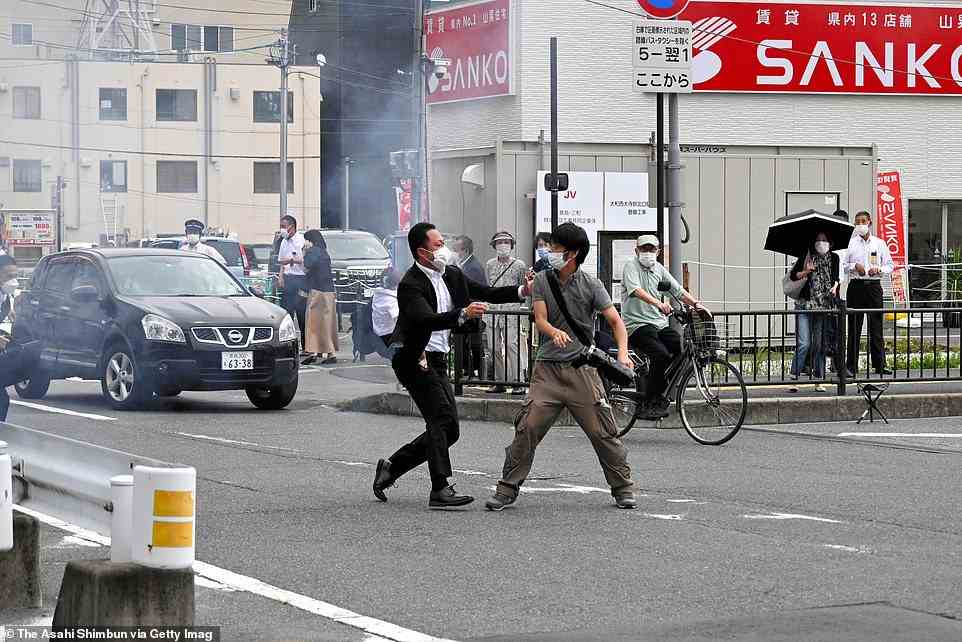
The suspected gunman who allegedly shot former Prime Minister Shinzo Abe in front of Yamatosaidaiji Station is seized by a security police officer
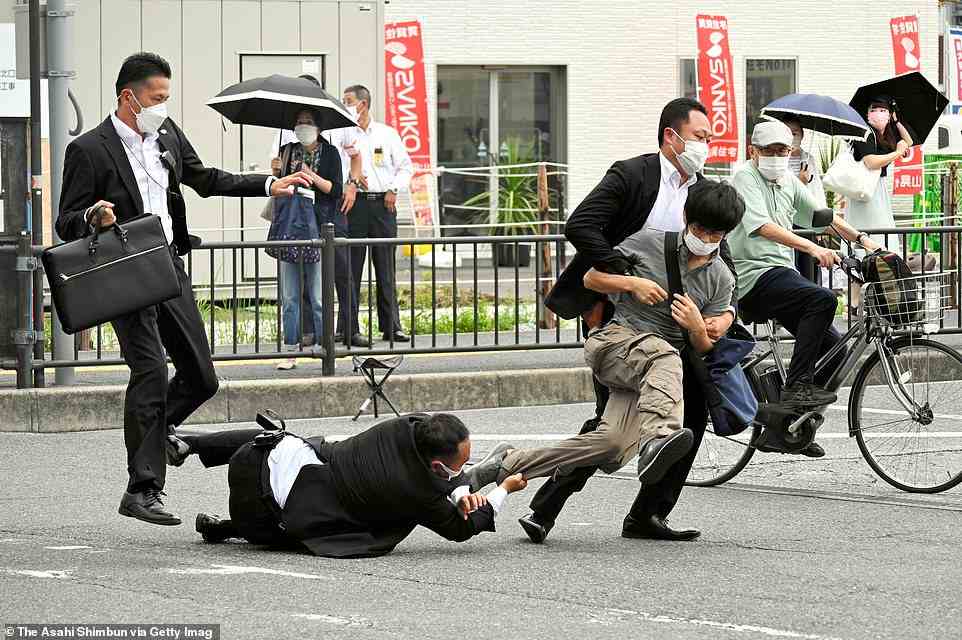
Police tackle the suspect who is believed to shoot former Prime Minister Shinzo Abe
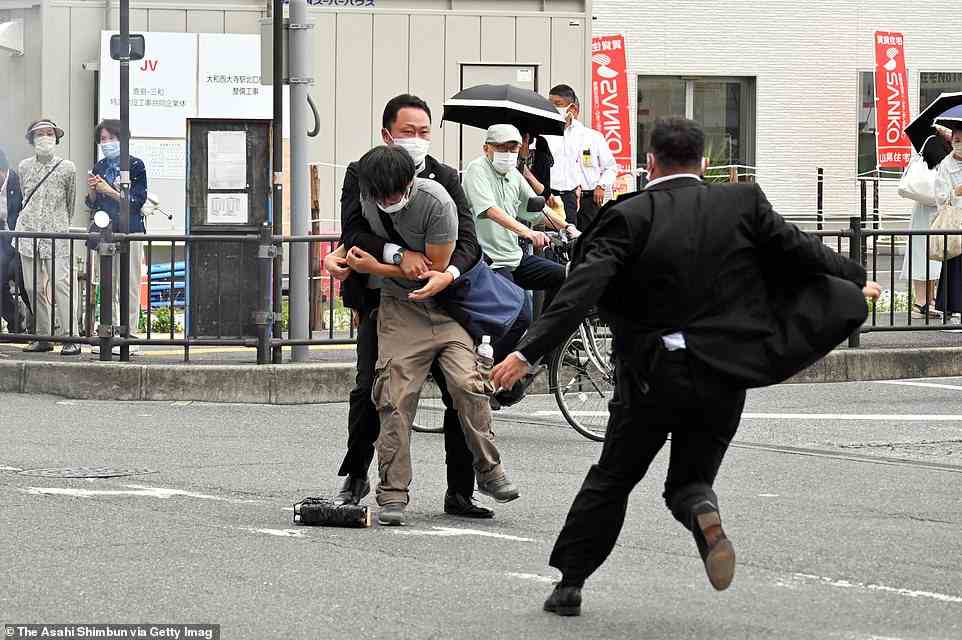
Security police tackle to arrest a suspect who is believed to shoot former Prime Minister Shinzo Abe
Local media including national broadcaster NHK and the Kyodo news agency said the former prime minister appeared to be in ‘cardiorespiratory arrest,’ a term often used in Japan before a feared death can be officially confirmed by a coroner.
The former leader had been delivering a stump speech at an event ahead of Sunday’s upper house elections when the apparent sound of gunshots was heard, NHK and the Kyodo news agency said.
‘He was giving a speech and a man came from behind,’ a young woman at the scene told NHK.
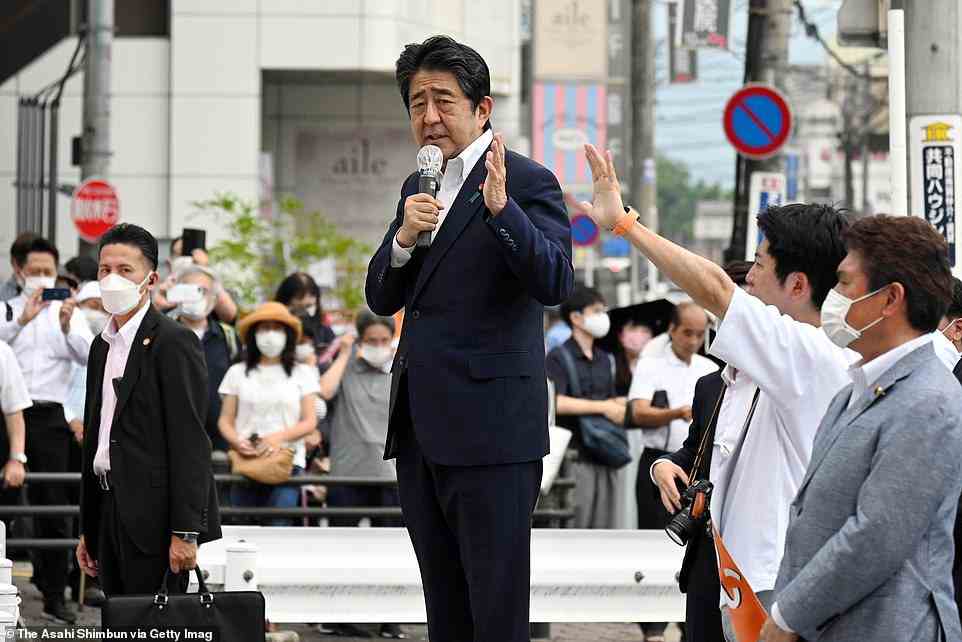
Abe makes a speech in front of Yamatosaidaiji Station moments before being shot on July 8
‘The first shot sounded like a toy. He didn’t fall and there was a large bang. The second shot was more visible, you could see the spark and smoke,’ she added.
‘After the second shot, people surrounded him and gave him cardiac massage.’
NHK showed video of Abe making a campaign speech outside a train station when two shots rang out, after which the view was briefly obscured and then security officials were seen tackling a man on the ground. A puff of smoke behind Abe could be seen in another video shown in NHK.
A Kyodo photograph showed Abe lying face-up on the street by a guardrail, blood on his white shirt. People were crowded around him, one administering heart massage.
TBS Television reported that Abe had been shot on the left side of his chest and apparently also in the neck.

People watch TV news reporting Japan’s former Prime Minister Shinzo Abe was shot, in Tokyo
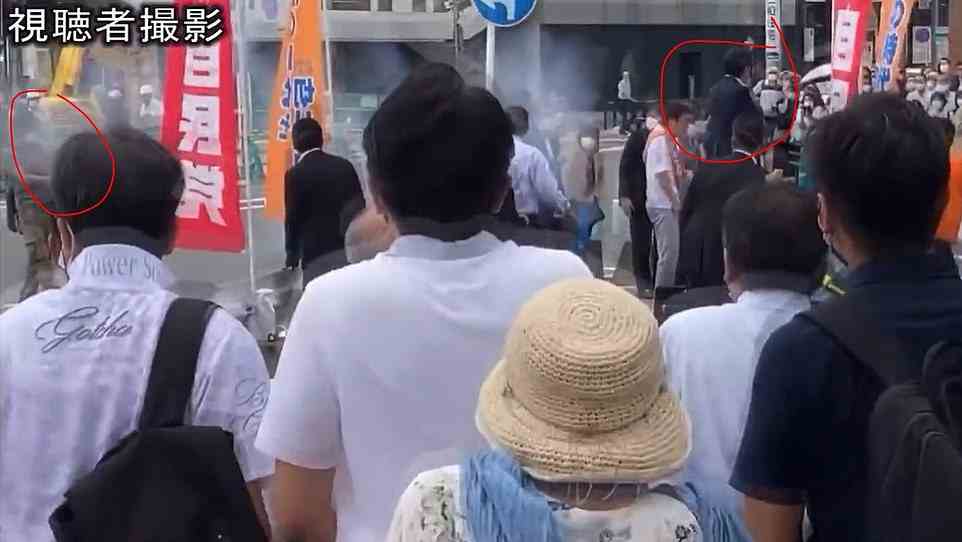
Former Japanese Prime Minister Shinzo Abe was shot in the chest while giving a speech in the western city of Nara on Friday and is showing no vital signs after reportedly being attacked from behind
The term heart failure means the heart cannot sufficiently pump blood and supply necessary oxygen to the rest of the body. In Japan, officials sometimes use the term to describe situations where victims are no longer alive but before a formal declaration of death has been made.
The government said a task force had been formed in the wake of the incident.
Prime Minister Fumio Kishida, who belongs to the same political party as Abe, is on his way to Tokyo on a helicopter from his own campaign destination of Yamagata, in northern Japan. Matsuno said all Cabinet ministers are to return to Tokyo from their campaign trips.
‘We are all saddened and shocked by the shooting of former prime minister Abe Shinzo,’ US Ambassador to Japan Rahm Emanuel said in a statement.
‘The US government and American people are praying for the well-being of Abe-san, his family, and people of Japan.’
Prime Minister Fumio Kishida’s special advisor Gen Nakatani told reporters ‘terror or violence can never be tolerated,’ Jiji reported.
Australian Prime Minister Anthony Albanese and U.S. officials expressed shock and concern over the shooting.
Our thoughts, our prayers are with him, with his family, with the people of Japan,’ Secretary of State Antony Blinken said while attending a Group of 20 foreign ministers meeting in Bali, Indonesia.
‘Abe-san has been an outstanding leader of Japan and unwavering ally of the U.S. The U.S. Government and American people are praying for the well-being of Abe-san, his family, & people of Japan,’ Ambassador to Japan Rahm Emanuel wrote on Twitter.

Panic-stricken security staff rush for help after the former prime minister was shot. The crowd was stunned by the attack
Political violence is rare in Japan, a country with strict gun regulations. The gun used in the shooting appeared to be home-made firearm, NHK said.
In 2007 Nagasaki Mayor Iccho Itoh was shot and killed by a yakuza gangster. The head of the Japan Socialist Party was assassinated during a speech in 1960 by a right-wing youth with a samurai short sword.
‘I thought it was firecrackers at first,’ one bystander told NHK.
Police identified the suspected shooter as Tetsuya Yamagami, a resident of Nara.
Abe served two terms as prime minister to become Japan’s longest-serving premier before stepping down in 2020 citing ill health.

Surveillance footage from above shows security staff rushing to assist the politician after the shocking shooting on Friday
Abe, Japan’s longest-serving prime minister, held office in 2006 for one year and again from 2012 to 2020, when he was forced to step down due to the debilitating bowel condition ulcerative colitis.
He stepped down as prime minister in 2020 because he said a chronic health problem has resurfaced.
Abe has had ulcerative colitis since he was a teenager and has said the condition was controlled with treatment.
He told reporters at the time that it was ‘gut wrenching’ to leave many of his goals unfinished. He spoke of his failure to resolve the issue of Japanese abducted years ago by North Korea, a territorial dispute with Russia and a revision of Japan´s war-renouncing constitution.
That last goal was a big reason he was such a divisive figure.
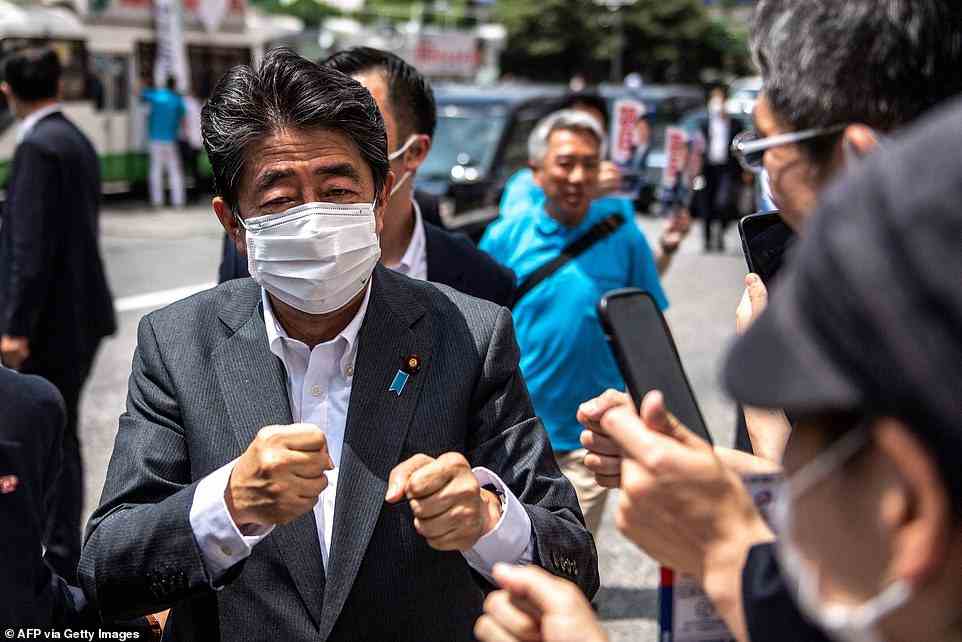
Earlier in the day, Abe was in good spirits as he interacted with supporters before his speech ahead of the House of Councillors election on July 10

This aerial photo shows the scene of gunshots in Nara, western Japan Friday, July 8, 2022. Japan’s former Prime Minister Shinzo Abe was shot and is reportedly in heart failure
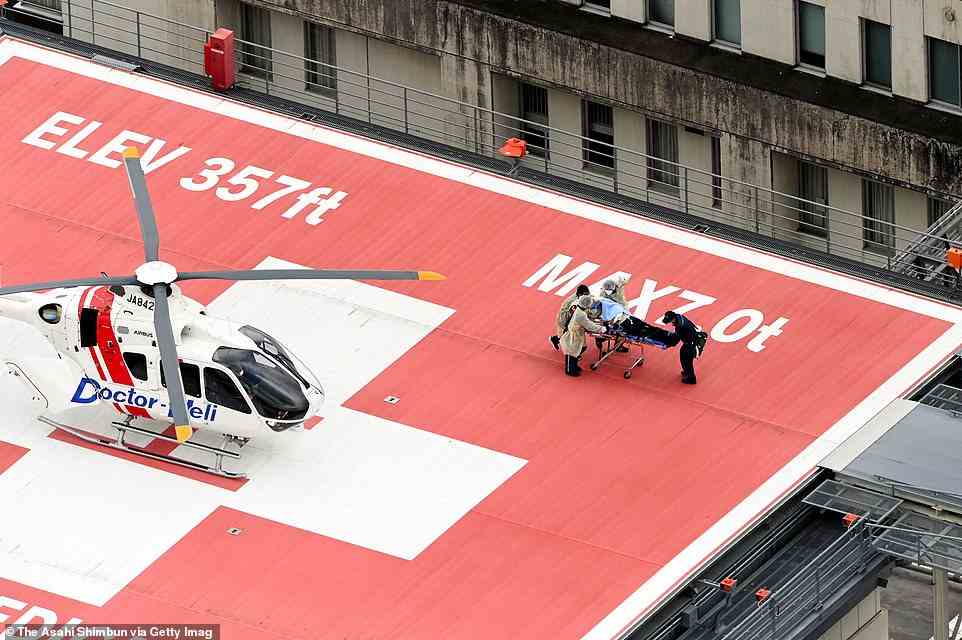
Former Prime Minister Shinzo Abe is on a stretcher to a helicopter after being shot in front of Yamatosaidaiji Station
His ultra-nationalism riled the Koreas and China, and his push to normalize Japan’s defense posture angered many Japanese. Abe failed to achieve his cherished goal of formally rewriting the U.S.-drafted pacifist constitution because of poor public support.
Supporters of Abe said that his legacy was a stronger U.S.-Japan relationship that was meant to bolster Japan´s defense capability. But Abe made enemies too by forcing his defense goals and other contentious issues through parliament, despite strong public opposition.
Abe is a political blue blood who was groomed to follow in the footsteps of his grandfather, former Prime Minister Nobusuke Kishi. His political rhetoric often focused on making Japan a ‘normal’ and ‘beautiful’ nation with a stronger military and bigger role in international affairs.
U.S. Ambassador to Japan Rahm Emanuel expressed sadness and shock at the shooting. ‘Abe-san has been an outstanding leader of Japan and unwavering ally of the U.S. The U.S. Government and American people are praying for the well-being of Abe-san, his family, & people of Japan,’ he said on Twitter.

